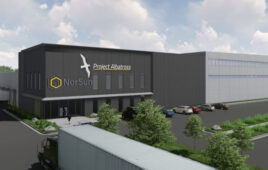Iron County, Utah, is achieving some firsts for solar in 2023. The county has hosted several large-scale solar projects since the early 2010s, and by year’s end it will have close to 1.5 GW of PV production within its borders.

Appaloosa Solar 1 is one of the first solar projects in the United States to opt for production tax credits over the investment tax credit. rPlus Energies
The latest project approaching completion there is Appaloosa Solar 1, a 200-MW array built about 15 miles northwest of Cedar City. Appaloosa is not only one of the largest projects in Iron County, but it is also among the first PV projects in the United States to opt for the production tax credit (PTC) following the enactment of the Inflation Reduction Act (IRA).
Appaloosa was originally developed by renewable energy contractor rPlus Energies and started construction in September 2022. It was later acquired by independent power producer and investor Greenbacker Capital, which will be Appaloosa’s long-term owner and operator.
“When we were analyzing the project, given that it’s in southwest Utah and generally has a very high solar resource — meaning that per-megawatt installed, there’s a pretty high yield compared to a project in Maine, for example — a credit that is based on ongoing production of the site rather than the investment upfront was a more desirable structure,” said Donal Mahoney, assistant VP of Greenbacker.
Before the IRA, the PTC wasn’t available to solar PV projects in the United States. Unlike the investment tax credit that provides a 30% credit on an energy project’s total cost, the PTC gives system owners an ongoing credit of 2.75¢ per kilowatt-hour of production for 10 years.
“It all comes down to a cost-benefit analysis of how much resource there is from a production credit vs. how expensive it is to build, effectively,” said Ben Tillar, CFA and principal at Greenbacker.

Appaloosa Solar 1 was built so it wrapped around the existing Three Peaks Solar project. rPlus Energies
Appaloosa’s site conditions convinced Greenbacker to opt for the PTC, along with the company’s prior experience with this version of tax credit on wind projects. Appaloosa is in the high desert of the Colorado Plateau at an elevation of approximately 5,800 ft. As elevation increases, the amount of atmosphere that light must pass through decreases, leading to greater power generation in solar panels.
That was the case with Three Peaks Solar, an 80-MW array that was built on the same site as Appaloosa in 2015. That prior experience of developing and building Three Peaks and other solar projects in Iron County streamlined the permitting process for new large-scale solar projects like Appaloosa, said Luigi Resta, president of rPlus Energies.
“These are some of the highest-performing solar projects in the country,” he said. “If you look at the data, because of high elevation, low thermal degradation during the summertime, because it’s cooler than the low deserts where it gets really hot, you have a high solar resource. And then the modules are kept clean.”
Not a single solar panel on Three Peaks has ever been cleaned by hand, and what little dust that has rested there is wiped away by rain and snowfall. Appaloosa was installed so that it wraps around Three Peaks on three sides of the existing array, so it’s expected to have similar levels of production and upkeep.
Site preparations for the system were minimal. It follows the contours of land that’s inhabited by low-growing sage and desert grass, including an area protected for native prairie dog habitat.

Appaloosa Solar 1 is one of many projects in Iron County, Utah. rPlus Energies
“We recently took a group of Bureau of Land Management and Dept. of Natural Resources folks to see what it looks like post-construction, and they were amazed because of how little disruption was made to the actual environment,” Resta said. “Now that the native grasses are growing back, they can see that it’s not just scorched earth underneath a solar project.”
Solar’s presence in Iron County has been tangible beyond generating energy and tax credits. The array was built by a local workforce of upwards of 200 people. The site was once only accessible by a dirt road, but the project developers paved three miles of that street. Appaloosa and Three Peaks are both installed on a family-owned plot of land.
“Appaloosa Solar 1 was a product of those relationships within the community,” Resta said. “A lot of the workforce in the subcontract has come from the region, which is really important to us, and it has been to Iron County, as well.”
Appaloosa is composed of ET Solar 540-W modules, Nextracker Horizon single-axis trackers, Sungrow 3600UDMV inverters and Shoals combiner boxes. Sundt Construction, which previously worked with rPlus on another solar project in the state, provided EPC services for this project.
At the time of writing, construction of Appaloosa was completed, and the project was awaiting back-feed approval from the utility. Once it’s online and interconnected, the array will support Facebook’s parent company, Meta, through two long-term power purchase agreements.
One family-owned plot of land in Iron County now hosts 280 MW of solar production. Both solar projects will feed electricity into the same substation but opted for different tax incentives. Regardless of subsidies, Iron County is greener for its solar presence.
“The industry is aware of the challenges with interconnection queues, with procurement, with RFP responses,” Resta said. “So, when we can bring a project to start of construction and then completion — and successful completion on time, on schedule and on budget — it helps the overall industry to be successful, to go into the next project, to say, ‘Yes, we can do this.’”





The PTC is 2.75c per kWh, not MWh.
Updated, thank you!